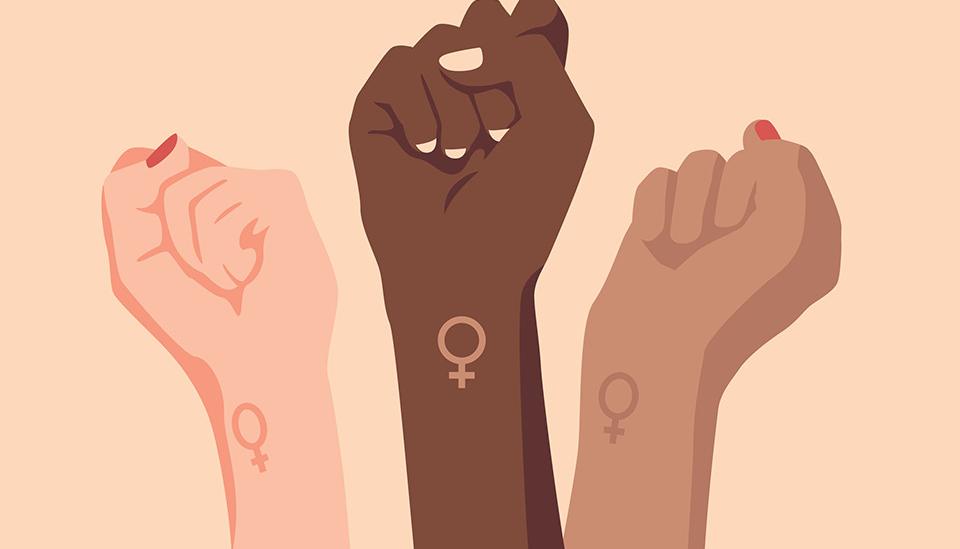During the ongoing COVID19 pandemic, the World Bank referred to gender-based violence as a global pandemic that affects 1 out of 3 women in their lifetime. Yet, this invisible pandemic is not novel and it is ever-present in our society, the consequences of which affect women’s right to live with dignity and access to opportunities. In February and March, I visited some unauthorized colonies in Nehru Nagar, South East Delhi, to conduct the fieldwork for my dissertation. My work primarily focused on understanding the role of NGOs in addressing gender-based violence against women. My research involved interactions with women and girls to understand the problems faced by them on account of their gender. While alcoholism and domestic violence were some serious issues that impacted a few women, what struck me the most was the internalization of the patriarchal ideology by young girls of 15 years old. It seemed that they had given up all hopes of attending school and making a career for themselves. Three of the girls with whom I interacted in the Adivasi Camp – Shreya, Babita and Guddi (names changed) shared their dreams of becoming a dancer, a singer and a fashion designer respectively. They confessed that by virtue of being female, they could not attend school beyond ninth grade. Further, they agreed with their families that girls do not need to acquire education as they mostly have to stay indoors and perform household chores. One does not need to guess that their withdrawal from school was due to their families’ concern for their ‘safety’, mainly because these girls have attained puberty. They confessed that the only exciting event in their future would be their marriage and they had no choice but to give in to their parents’ wishes. The sheer submissiveness of these young girls made me realize that there exist two worlds in the national capital and the rift between the two is alarming and even shameful.
A pertinent question that must arise in our minds is that if even today young girls are not able to complete their schooling then how would the vision of our Prime Minister of creating an ‘Atmanirbhar Bharat’ be fulfilled? Self-reliance requires the development of one’s full potential so that we can reduce our dependence on others. Women are not only the untapped resource of the nation, but they are human beings first who are entitled to a dignified life. The girls in the Adivasi camp coolly shared that they do not use mobile phones by virtue of being female. One of them shared- “Hum bahar jaate nahi, hum kyu mobile phone rakhe? Koi zaroorat nahi hain. Hum ladki hain” (We do not go outdoors. Why should we keep mobile phones with us? We don’t need it. We are girls.) One must wonder that in such a scenario when girls and women do not even have access to mobile phones, how can they seek help from domestic violence helplines in the event of abuse or violence.
Laws alone cannot guarantee a gender-just society. We need to explore avenues of collaboration with civil society members and organizations which can engage with the people to discuss these social issues and help them unlearn patriarchal norms and values. In my research, I have analyzed the critical work done by grassroots NGOs for women through a case study of NGO Shakti Shalini, which is working with these communities. The government has limited access when it comes to the domain of culture, and for this reason, NGOs can operate as outreach workers of the government. This collaboration will only succeed if NGOs continue to stay true to their flexible nature of working, which is different from the legalistic and formalistic approach of the government.
NGO Shakti Shalini carries out its Community Outreach Program in six localities in South East Delhi district. It refers to these localities as “communities” which encompasses marginalized sections of society with poor income background. Their social status largely determines their life course. In my understanding, the NGO uses the term “communities” to refer to the localities where it works because it strives to create solidarity within and among families so that they realize their common concerns and work towards eradicating them collectively. The term, therefore, is very uplifting because it gives power to the people. The concept of power as conceptualized by Hannah Arendt identifies the people and not the government as the locus of power. Power here has a positive connotation and it refers to “collective will” of the people. The organization prioritizes the role of choice and agency while addressing different types of violence faced by women in these communities. Through these programs it aims to sensitize and educate not just the women but the menfolk too. It also focuses on imparting various skills to women so that they can lead an independent life. It adopts a feminist approach towards women empowerment that focus on increasing “awareness, autonomy, self-reliance, rights, engagement in decision-making process, capacity building, and certain level of power”.
Some staff members who were previously working with the government in the social sector shared that NGOs and other government-led organizations operate by different goals and values. For instance, a member shared that government-run organizations are motivated by data collection of the number of victims they rescued and rehabilitated and they ignore the needs of the victims after they are sent to shelter homes. Therefore, their work does not aim to correct the root cause of the problem but merely offer a band-aid solution. A possible reason behind this could be that the work done by these organizations is often linked with the performance of the government; this could partially justify their obsession with statistics. Further, they do not put enough emphasis on preventive measures to stop violence against women. Further, their impact is limited as they have to follow standard rules for all cases. They have a very formal work culture, and strict hierarchy is observed which makes it very difficult for the staff and interns in government-run shelter homes to come out of their comfort zone and present a new idea. As a result, the skills and potential of the staff members are not utilized and their autonomy is not respected. However, the work culture in private NGOs is starkly different. The staff of Shakti Shalini shared that there is a feeling of equality and empathy among all the members. This enables the team members to exercise considerable autonomy in introducing new ideas and thus they feel empowered in their job. The interns shared that since they got in touch with this organization, they have always felt free to choose a project of their choice and to carry any workshop or activity in the communities or in the shelter home as long as it benefits the people and it aligns with the goals of the organization. On the contrary, members of government-run shelter home do not experience this sense of autonomy and empowerment. As Shakti Shalini works towards ending violence against women, they are very particular about not being even remotely violent towards any other person and thus, for this reason, they ensure that the autonomy of its team members does not get violated or their rights are not taken away in the process. It was also shared that Shakti Shalini follows a humanitarian approach and it puts the needs of the victim first.
Further, vast differences exist in the facilities provided in shelter homes run by NGOs and those run by the government. In ‘Pehchan’ the shelter home of Shakti Shalini people receive decent household facilities and they enjoy considerable freedom which creates a conducive environment for their growth. Even in situations of low funds, there is no drastic change in the lifestyle of the residents as they always live a simple and sustainable life and the funds are managed well by the organization. Some of the inhabitants of the shelter home shared that in government-run shelter homes, women do not even have access to a fridge nor can they eat as per their wish. An example was given of one such shelter home, where the food served in fixed quantities is collected from a small window outside the kitchen and women residents take the plate to their rooms to eat. But in Shakti Shalini, everyone participates in the cooking process and they sit together and eat like a family. There is also no rule about how many servings a person can take. Another difference brought out was in the rehabilitation process of NGOs and those of government-run shelter homes. The latter enrol a person in the shelter home for a short term period of three months or the recommendation of the concerned courts and then renews the permission by exercising their discretion. However, there is no time limit for the rehabilitation process in Shakti Shalini. This is a very pragmatic policy as it is difficult to ascertain beforehand how long the rehabilitation process will take for any individual. Thus, they are sensitive to the needs of the victims which includes: a stable home, emotional wellbeing and a friendly environment.
While the government has launched several campaigns and schemes to promote the education of girls, however, the experiences of the girls in these colonies show that these schemes have not benefited them. One can critically assess the Beti Bachao, Beti Padhao campaign in which the government has spent between 65 per cent to 90 per cent of the total funds issued on publicity alone since 2016 and only less than 5 per cent of funds were used for interventions in the education and health sector. The likes of Sherya, Babita and Guddi, exist all across our country. If in spite of living in the national capital girls face these challenges, then one should shudder at the thought of how much control do girls in other parts of the country exercise over their lives. Gender discrimination not only deprives women of leading a dignified life based on their terms, but it is also a significant impediment to achieving overall prosperity and development of the country. While the Republic dreams of becoming self-reliant, we must realize the crucial role of gender justice and a sound model of development in achieving this goal.
genderRead more: The Growing Burden of Child Malnutrition in India
Post Disclaimer
The opinions expressed in this essay are those of the authors. They do not purport to reflect the opinions or views of CCS.






